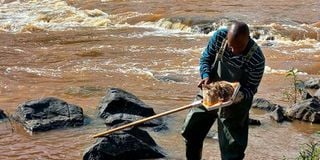Premium
The slow death of Mara River

What you need to know:
- Fewer or no micro invertebrates, like on the day we visited, show that the river is being polluted.
- The polluted Mara River starts from the Mau escarpments and can go all the way to Lake Victoria.
What if you woke up to news of a river’s death? Will you cry for the poor river? Or, will you brush it off like you do when you step on a cockroach?
A dying river knows no age. A dying river does not have hospital appointments to be resuscitated or given medicine. A dying river is hurt by our actions. Its ill health, like a boomerang, comes back to pinch us and the animals that depend on it for a home and survival. It may die eventually, but its death will be felt by you, whose actions hurt the river.
Healthy Nation visited the Mara River in Narok County located at the Mara-Serengeti ecosystem, whose health, at the time of visit, was not as stable.
A few metres to where the river is, its roaring burble and fresh air welcomes you to a site that is the reason for the eighth wonder of the world – the wildebeest migration.
The crisp air makes you forgive the unforgiving sun whose rays are right above your head. The blue sky and beautiful patches of the white cumulus clouds indicate a bright day. The forest on the sides of the river is full of life, green and tightly packed. The rocks by the river banks are peacefully unfazed. The water is not as violent but it commands its presence one small tide at a time. The level of the water is manageable, a perfect day to serenely check the river’s health.
Healthy Nation meets Paul Rono, secretary for the Mara River Users Association who, together with his team, keeps tabs on the river’s health by checking its turbidity and the level of pollution.
Turbidity is a test taken to check water’s quality by looking at its visible characteristics such as clarity or cloudiness.
And, the other way to check the health of the river is by scouting for the presence or absence of micro invertebrates that die, depending on their sensitivity, when the water is polluted.
Fewer or no micro invertebrates, like on the day we visited, show that the river is being polluted.
Mr Rono and his team have their gears on, ready to look out for the presence of sensitive micro invertebrates such as stoneflies and beetles that cannot withstand a polluted river. The team does the assessment on a monthly basis. Afterwards, together with the National Environment Management Authority, the Water Resource Authority and the county’s Public Health team, they reach out to point sources when the river is highly polluted.
“When the water is highly polluted, some of the micro-invertebrates die instantly. For instance, when raw sewage is poured into the water, it may have sensitive chemicals that could kill the invertebrates. When we do our assessment in the river and fail to spot them, we know that something is going on upstream and we track to inform the point sources,” he explains. Having worked in the field for a number of years, Mr Rono knows a number of point sources that are the reason for the pollution in the Mara. Camps, hotels, hospitals, construction sites, small and large scale farmers are a major cause for worry.
“Degradation is already happening in the upper zone. We have seen an increase in land subdivision, which means that more people are opening up farms for agriculture and development. We realised that every day, we are losing tree cover, which is degrading our environment and there is a lot of siltation in the river,” Mr Rono tells Healthy Nation.
“In the middle of the Mara River, we have large scale farmers who use chemicals and machinery that lead to rampant soil erosion,” he adds.
“However, all hope is not lost, we tell the farmers what to do, especially those from point sources who utilise a lot of chemicals.”
The polluted Mara River starts from the Mau escarpments and can go all the way to Lake Victoria.
Mr Rono explains that when people encroach the Mau Forest and practise illegal logging, charcoal burning and some use the land for farming, it affects the water in the Mara River. “Without Mau, there is no Mara,” he asserts.
Mr Samson Lenjir, World Wide Fund for Nature’s coordinator for the Mau-Mara sub-landscape, also says the forests’ connection to the river is correlational.
“Forests are connected to rainfall and people should realise that what they do at the Mau will definitely affect the Mara River,” he says.
Prof Nick Oguge of the University of Nairobi and Chief of Party Economics of Natural Capital in East Africa, explains that not all fertilisers applied in farms are utilised by crops.
“Some of them are washed away into rivers, which may end up in lakes. Lake Victoria is highly fertilised because of such chemicals, which in turn make the water hyacinth to bloom,” he says.
Mr Rono and his team are now encouraging community members to plant trees as the association grows tree nurseries with the aim of rehabilitating the degraded areas. While tree planting alone may not be sustainable, the association encourages growing of trees that bear fruits to sustain the community members who sell the fruits as a source of income.
A study published earlier this year by the scientific journal Frontiers in Water, which examined four main water catchment in Kenya; Nzoia, Sondu-Miriu, Nyando and the Mara, noted: “The Mara River catchment had the least land area utilised for crop farming but it has undergone significant changes in land use over the last five decades, with increased sediment load as a result of pollution.”
The study also anaylsed water quality and just like Mr Rono and his team, they identified what could be ailing the river.
“The basin is impacted by multiple stressors arising from land use and land cover changes, agricultural expansion and intensification to human intrusions and the millions of inhabitants at the basin. Nutrient loading from diffused agricultural sources and organic loading, mainly from large herds of domestic and wild grazers in the Mara River,” they highlighted. Adding that; “These stressors were shown to have significant and distinct impacts on fish communities in the rivers.”




